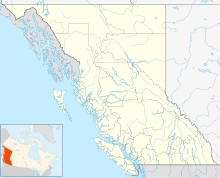Yellowhead Pass facts for kids
Quick facts for kids Yellowhead Pass |
|
|---|---|

CNR GP9 in the Yellowhead Pass
|
|
| Location | Alberta, British Columbia, Canada |
| Elevation | 1,131 m (3,711 ft) |
| Founder | Canadian Northern Railway Grand Trunk Pacific Railway |
| Original use | Mountain pass |
| Governing body | Parks Canada |
| Yellowhead Pass | |
|---|---|
| Elevation | 1,131 m (3,711 ft) |
| Traversed by | Yellowhead Highway and Canadian National Railway; Via Rail's Canadian, Via's Jasper – Prince Rupert train and the Jasper section of the Rocky Mountaineer using CN tracks |
| Location | Jasper National Park, Alberta / Mount Robson Provincial Park, British Columbia, Canada |
| Range | Canadian Rockies |
The Yellowhead Pass is a special pathway through the Canadian Rockies mountains. It crosses the Continental Divide of the Americas, which is like a giant line that separates rivers flowing to the Pacific Ocean from those flowing to the Atlantic or Arctic Oceans. This pass is located right on the border between two Canadian provinces: Alberta and British Columbia. It's also found within two beautiful parks: Jasper National Park and Mount Robson Provincial Park.
Why is Yellowhead Pass Important?
The Yellowhead Pass is not very high, only about 1,131 meters (3,711 feet) above sea level. It also has gentle slopes, making it easier to travel through compared to other mountain passes. Because of this, it was once suggested as the best route for the Canadian Pacific Railway. This railway was a huge project to connect Canada from east to west.
A Path for Trains and Cars
Even though the Canadian Pacific Railway chose a different, harder route, the Yellowhead Pass became very important later on. Two other big railway companies, the Grand Trunk Pacific Railway and the Canadian Northern Railways, built their main tracks through this pass between 1910 and 1913.
Today, the main railway line of the Canadian National Railway still uses this route. You can also find famous passenger trains like Via Rail's Canadian and the Rocky Mountaineer traveling through here. The Yellowhead Highway, a major road, also follows this historic path, making it easy for cars and trucks to cross the mountains.
Who Was Yellowhead Pass Named After?
The pass is believed to be named after a man called Pierre Bostonais. He was an Iroquois-Métis trapper. People nicknamed him Tête Jaune, which means "yellow head" in French, because he had blond hair.
Pierre Bostonais worked as a guide for the Hudson's Bay Company, a very old trading company. In 1820, he led one of the first trips for the company into what is now the interior of British Columbia, using this very pass. His nickname stuck, and that's how the Yellowhead Pass got its name!


